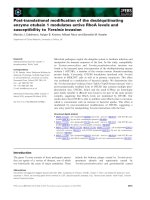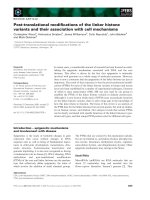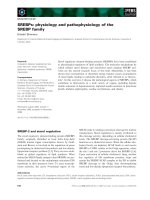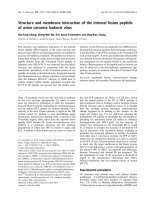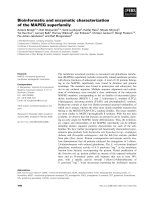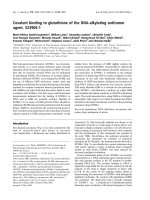Báo cáo khoa học: O-MACS, a novel member of the medium-chain acyl-CoA synthetase family, specifically expressed in the olfactory epithelium in a zone-specific manner doc
Bạn đang xem bản rút gọn của tài liệu. Xem và tải ngay bản đầy đủ của tài liệu tại đây (362.54 KB, 10 trang )
O-MACS, a novel member of the medium-chain acyl-CoA synthetase
family, specifically expressed in the olfactory epithelium
in a zone-specific manner
Yuichiro Oka, Ko Kobayakawa, Hirofumi Nishizumi, Kazunari Miyamichi, Satoshi Hirose, Akio Tsuboi
and Hitoshi Sakano
Department of Biophysics and Biochemistry, Graduate School of Science, The University of Tokyo, CREST Program of Japan Science
and Technology Corporation, Japan
In rodents, the olfactory epithelium (OE) can be divided into
four topographically distinct zones, and each member of the
odorant receptor (OR) gene family is expressed only in one
particular zone. To study the functional significance of the
zonal structure of the OE, we searched for genes expressed
in a zone-specific manner by using the differential display
method. Among the clones isolated from the rat OE, we
characterized a novel olfactory protein termed O-MACS, a
member of the medium-chain acyl-CoA synthetase family.
The o-macs gene encodes a protein of 580 amino acids,
sharing 56–63% identity with other MACS family proteins.
RT-PCR analysis demonstrated that the o-macs gene is
expressed only in the OE, unlike other MACS family genes.
In situ hybridization revealed that the o-macs transcripts are
present in the neuronal cell layer of olfactory sensory neu-
rons (OSNs) as well as in the supporting and basal cell layers
in the most dorso-medial area (zone 1) of the OE. Develop-
mental analysis revealed that the o-macs gene is already
expressed on embryonic day 11.5, before the onset of the OR
gene expression, in a restricted area within the rat olfactory
placode. Recombinant O-MACS protein tagged with c-Myc
and His6 demonstrated an acyl-CoA synthetase activity for
fatty acid activation, and protein localization to mitochon-
dria like other MACS family proteins. The present study
indicates that this novel protein may play important roles in
processing odorants in a zone-specific manner, or the zonal
patterning of the OE during development.
Keywords: differential display method; olfactory epithelium;
odorant receptor; odorant processing; medium-chain acyl-
CoA synthetase.
The olfactory system of mammals can recognize a variety
of different odorants with G-protein-coupled odorant recep-
tors (ORs) [1–3]. A multigene family encoding hundreds of
related OR molecules was first identified in rat [4]. It has
been reported that each olfactory sensory neuron (OSN)
expresses only one OR gene in a mono-allelic manner [5–8].
In situ hybridization revealed that the olfactory epithelium
(OE) can be divided into four topographically distinct
zones, and that each OR gene is expressed in one particular
zone [9,10]. Furthermore, OSNs expressing the same OR
gene project their axons to a pair of glomeruli on the lateral
and medial sides of the olfactory bulb (OB) [11–13]. Thus,
odorant stimuli that activate a specific set of OSNs in the
OE are converted to a topographic map of activated
glomeruli on the OB [14]. Although the zone-to-zone
correlation between the OE and the OB has been proposed,
the mechanisms that control the zone-specific expression of
and zonal projection for ORs are still largely unknown.
In order to study the functional significance of the zonal
structure, we have isolated genes that are expressed
differentially between the most dorso-medial and the most
ventro-lateral zones of the rat OE by using the differential
display (DD) method. In the present study, we have
analyzed a novel gene termed o-macs, a member of the
medium-chain acyl-CoA synthetase (MACS) gene family.
In situ hybridization revealed that o-macs is expressed
specifically in the olfactory system, in the most dorso-medial
area (zone 1) of the OE. It is known that acyl-CoA
synthetase is involved in the initial step of fatty acid
metabolism, i.e., the reaction of fatty acid with CoA to
produce acyl-CoA on the outer membrane of mitochondria.
Acyl-CoA is then transported into the matrix for
b-oxidation of acyl-group. Among the MACS family
proteins with the acyl-CoA synthetase activity, two murine
proteins, MACS1 and SA, were detected in the liver and
Correspondence to H. Sakano, Department of Biophysics &
Biochemistry, Graduate School of Science, The University of Tokyo,
2-11-16 Yayoi, Bunkyo-ku, Tokyo, Japan.
Fax: +81 3 5689 7240; Tel.: +81 3 5689 7239;
E-mail:
Abbreviations: AceCS, acetyl-CoA synthetase; AST-IV, aryl sulfo-
transferase IV; DIG, digoxigenin; DD, differential display; GST,
glutathione S-transferase; IVD, isovaleryl-CoA dehydrogenase;
LACS1, long-chain acyl-CoA synthetase 1; MACS, medium-chain
acyl-CoA synthetase; OB, olfactory bulb; OE, olfactory epithelium;
OMP, olfactory marker protein; OP, olfactory placode; OR, odorant
receptor; OSN, olfactory sensory neuron; PST, phenol sulfotrans-
ferase; RE, respiratory epithelium; VNE, vomeronasal epithelium;
VLACS, very long chain acyl-CoA synthetase.
Enzymes: Medium-chain acyl-CoA synthetase (EC 6.2.1.2).
Notes: DNA databank of Japan (DDBJ) accession number for the
O-MACS sequence is AB096688.
(Received 24 December 2002, revised 10 March 2003,
accepted 14 March 2003)
Eur. J. Biochem. 270, 1995–2004 (2003) Ó FEBS 2003 doi:10.1046/j.1432-1033.2003.03571.x
Table 1. Summary of differential display screening. The cDNA pools from zone 1 and zone 4 of the rat olfactory epithilium (OE) were compared with the differential display (DD) method. Among bands
displayed, about 0.5% bands showed difference between the two zones. The DNA fragments were cloned and subjected to the sequencing analysis, indicating that they are classified into six categories
(Intracellular enzymes, Secreted/membrane proteins etc.) based on their predicted structures and functions. The number of clones in each category is indicated in parentheses where cases are not named in
table. The expression zone of each clone analyzed by in situ hybridization is indicated in ÔZoneÕ columns; ND, not detected in the OE; NP, not performed. The expression cell layers are indicated in ÔCell layerÕ
columns as S, supporting cells; N, olfactory sensory neurons; B, basal cells; L, lamina propria. *, Patched expression. The expression in tissues other than the OE is also shown in ÔCell layerÕ column as BG,
Bowman’s gland; LNG, lateral nasal grand; RE, respiratory epithelium.
Clone preferentially amplified in zone 1 in DD Zone Cell layer Clone preferentially amplified in zone 4 in DD Zone Cell layer
Intracellular enzymes
Rat phenol sulfotransferase 1 S Rat 1-Cys-peroxiredoxin 2<3<4 S,N,B
Rat paraoxonase 1 S Rat oxidative 17-b hydroxysteroid
deydrogenase type 6
ND –
Rat very long chain acyl-CoA synthetase 1>2>3 S,N,B Rat nucleoside diphosphate kinase ND –
Rat glutathione transferase subunit 8 ND – Rat aryl sulfotransferase IV 2<3<4 S,N,B
Rat RY2D1 odorant metabolizing protein ND BG Rat Isovaleryl-CoA dehydrogenase 2,3,4 S*
Rat o-macs 1 S,N,B,L Rat glutathione S-transferase-Yb 2<3<4 S,N,B
Mouse carbonyl reductase 2 like 1>2>3>4 S,N Rat glutathione S-transferase P ND –
Mouse crystalline mu like ND – Rat cytochrome P-450 isozyme 5 ND –
Mouse spermine synthase (Sms) like ND – Rat aldehyde dehydrogenase 1 ND –
Rat epoxide hydrolase ND –
Rat membrane lipid desaturase 1<2<3<4 S
Secreted/membrane proteins
Rat RY2G5 potential ligand binding protein ND BG Rat RYF3 (vomeromodulin) ND LNG
Rat mucin-like protein 1,2,3 S Rat RYA3 potential ligand binding protein ND BG
Rat cocaine, amphetamine-regulated transcript 1>2 N Rat RYD5 potential ligand binding protein ND BG
Rat protocadherin-7c 1>2>3 N* Rat neuromedin U ND –
Rat secretogranin III 1<2<3<4 N
Rat Apolipoprotein E ND L
Rat osteopontin ND Bone
Rat Na
+
/K
+
-ATPase a subunit 1<2<3<4 N
Mouse MOR10 like 4 N*
Mouse Ym1 like 2,3,4 S*
Signal transduction
Rat guanine nucleotide releasing protein ND – Rat IGF binding protein 5 ND –
Rat FGF receptor activating protein 1 ND –
Rat PKC delta-binding protein ND –
Rat cellular retinoyl-binding protein ND –
Mouse rho (NET1A) like ND –
Transcription factor
(0) Mouse GATA-2 like ND –
Mouse forkhead box C1 like ND –
Mouse BSPRY like ND –
1996 Y. Oka et al. (Eur. J. Biochem. 270) Ó FEBS 2003
kidney with different substrate specificities [15]. In contrast
to these MACS family proteins, O-MACS is detected
neither in the liver nor the kidney, but specifically in the OE
in a zone-specific manner. Although O-MACS demonstra-
ted MACS activity for the straight and saturated-fatty acids
like other MACS proteins, its substrate preference was
shown to be fatty acid lengths of C
6
–C
12
. Here we report the
initial characterization of the novel protein, O-MACS, and
discuss its possible roles in olfaction and in the development
of the olfactory system.
Experimental procedures
cDNA cloning of
o-macs
Studies were performed in accordance with the guidelines
for animal experiments at the University of Tokyo. Three-
week-old-male Wistar rats were anesthetized with pento-
barbital sodium (10 mg per animal) and decapitated.
Olfactory epithelia were dissected and embedded. After
sections (40-lm thick) were prepared, tissue pieces
corresponding to zone 1 and zone 4 were excised with
scalpels and collected in 1.5 mL tubes. Total RNA was
extracted with RNeasy kit (Qiagen, Hilden, Germany).
After DNase I digestion, cDNAs were synthesized with
three sets of poly(dT) primers, gT
15
A, gT
15
CandgT
15
g,
using SuperScript
TM
II reverse transcriptase (Invitrogen,
Groningen, Netherlands). Fluorescent DD screening was
performed as described [16]. The prospective cDNA
fragments were cloned into a pGEM-T vector (Promega,
Madison, WI, USA) and sequenced. The Full-length
cDNA of rat o-macs was isolated with a direct cDNA
selection method [17] from the full-length cDNA pools
prepared with SMART
TM
PCR cDNA synthesis kit
(Clontech, Palo Alto, CA, USA). The isolated cDNA was
then cloned into a pGEM-T vector.
RT-PCR analysis
Total RNAs were extracted from tissues of 3-week-old
Wistar rat by RNeasy kit (Qiagen) and subjected to cDNA
synthesis. The PCR primers for o-macs, SA, KS, KS2 and
MACS1 are as follows: o-macs,5¢-atgaaggttctcctccgctg-3¢
(forward), 5¢-gcctttcgggacaaggagcc-3¢ (reverse); SA 5¢-aggt
gttttcagcgcctagc-3¢ (forward), 5¢-caccattactctgtctcctc-3¢ (re-
verse); KS 5¢-ccttctggggcactgagatg-3¢ (forward), 5¢-agaac
gcatgcagccgaggg-3¢ (reverse); KS2 5¢-tggtagctacctggga
agcc-3¢ (forward), 5¢-gaagcaccagactcattctg-3¢ (reverse);
MACS1 5¢-gagttggagctccaagctgg-3¢ (forward), 5¢-tgatccctgtt
cgcatgcag-3¢ (reverse).
In situ
hybridization
Olfactory epithelia were dissected from Wistar rats on
embryonic (e) days 12, 14, 16, 18 and postnatal (P) day 21.
Paraformaldehyde (PFA)-fixed sections (for P21 animals)
or fresh frozen sections (for embryos) (10 lm) were
hybridized with digoxigenin (DIG)-labeled antisense
RNA probes for the o-macs, OMP, OCAM, NCAM,and
NeuroD genes. cDNA fragments for the rat OMP, OCAM,
NCAM,andNeuroD were prepared by RT-PCR using
pairs of primers: OMP 5¢-gagtagagagcctgaagcag-3¢
Table 1. (Continued).
Others
Rat muscle myosin light chain 2 ND – Rat alpha-tropomyosin 2 ND –
Mouse Mpv-17 like protein like 1 S,N,B,L Rat RNA binding protein (transformer-2-like) ND –
Mouse CAAA01033971 region 1 S,N,B,L Rat interferon-inducible protein ND –
Human reticulon3 (RTN3) like ND – Rat metallothionein-1, pseudogene a ND –
Chick vitelline membrane outer layer protein like ND – Rat mitchondria ATP synthase beta subunit ND –
EST (6) ND – Mouse HMG 17 like ND –
Repeat (2) NP – Mouse heat shock protein 20-like protein like ND –
Mouse interferon regulatory factor 6 like ND –
Mouse palate unknown like ND RE
Human T-plastin like ND –
EST (8) ND –
Repeat (6) NP –
No homology
(10) ND – Clone #B10g 3<4 S
Others (21) ND –
Ó FEBS 2003 Zone-specific expression of olfactory MACS protein (Eur. J. Biochem. 270) 1997
(forward), 5¢-ggttaaacaccacagaggcc-3¢ (reverse); OCAM
5¢-gagaagtggtgtcccctcaa-3¢ (forward), 5¢-cctccatcatcttgctt
ggt-3¢ (reverse); NCAM 5¢-cttcctgtgtcaagtggcag-3¢ (for-
ward), 5¢-gttggcagtggcattcacga-3¢ (reverse); and NeuroD
5¢-aagacgcatgaaggccaatg-3¢ (forward), 5¢-catgatgcgaatggct
atcg-3¢ (reverse). Hybridization, washing, antibody reaction
and color detection were performed as described previously
[17], except that Proteinase K digestion was omitted for
embryonic samples. The hybridized sections were photo-
graphed with an Olympus AX70 microscope (Olympus
Optical, Tokyo, Japan) after counterstaining with 0.01%
methyl green.
Recombinant protein expression, purification
and MACS activity assay
The coding sequences of the rat o-macs and murine MACS1
genes were prepared by RT-PCR using a pair of primers:
EcoRI-rO-MACS-U (5¢-GAATTCatgaaggttctcctccactg-3¢)
and rO-MACS-XhoI-D (5¢-CTCGAGtgcccgtccccactcctggt-3¢)
for o-macs; EcoRI-mMACS1-U (5¢-GAATTCatgcagtggc
tgaagagttt-3¢) and mMACS1-XbaI-D (5¢-TCTAGAtagct
gaccaaactccttg-3¢)forMACS1, and cloned into the EcoRI/
XhoIorEcoRI/XbaI site of a pcDNA3.1/myc-His vector
version A (Invitrogen), respectively. Plasmids were trans-
fected into HEK293T or HeLa cells using the nonliposomal
transfection reagent FUGENE6 (Roche Diagnostics,
Mannheim, Germany) [18].
For purification, transfected HEK293T cells were cultured
for 60 h. After washing with NaCl/P
i
, cells were lysed in lysis
buffer [50 m
M
NaH
2
PO
4
(pH 8.0), 150 m
M
NaCl, 0.1%
Triton X-100, 20 m
M
imidazole, 16 lgÆmL
)1
benzamidine
HCl, 10 lgÆmL
)1
aprotinin, 10 lgÆmL
)1
leupeptin,
10 lgÆmL
)1
pepstatin A, 1 m
M
phenylmethanesulfonyl
fluoride], and subjected to sonication. The His6-tagged
proteins in cell lysate were bounded with Ni-NTA (Qiagen)
and eluted with elution buffer (50 m
M
NaH
2
PO
4
, 150 m
M
NaCl,0.1%Tween20,and1
M
imidazole). After eluent was
dialyzed against buffer A(50 m
M
NaH
2
PO
4
, 150 m
M
NaCl),
the protein solution was concentrated with Centricon
Ò
YM-50 (Millipore, Bedford, MA, USA). The protein content
was determined with protein assay kit (Bio-Rad, Hercules,
CA, USA) using bovine serum albumin (BSA) as a control.
For Western blotting, 5 lg of purified proteins were
subjected to SDS/PAGE (8%), and immunostained with
monoclonal antibodies for c-Myc (1 : 1000; Sigma) and
alkaline phosphatase-conjugated anti-mouse IgG (1 : 1000,
Promega).
Acyl-CoA synthetase activities were assayed with a
spectrometric method as described [19] using the rO-MACS
(1 lg) or mMACS1 (0.1 lg) protein in a 100-lL reaction
containing 0.5 m
M
of substrate.
Fig. 1. Comparison of MACS (medium-chain
acyl-CoA synthetase) family proteins. (A) Pre-
dicted amino acid sequences are compared
for the rat (r), mouse (m) and human (h)
O-MACS. Dots indicate identical amino acid
residues with the rat O-MACS. Sequences for
the AMP-binding motif are shaded. (B) Den-
drogram of acyl-CoA synthetase family
proteins. The tree was generated with a
CLU-
STAL X
program using amino acid sequences of
the mouse very long-chain acyl-CoA synthe-
tase (mVLACS), human long-chain acyl-CoA
synthetase 1 (hLACS1), mouse medium-
chain acyl-CoA synthetase proteins (mSA,
mMACS1, mKS, and mKS2), mouse acetyl-
CoA synthetase 1 (mAceCS1), and O-MACS
proteins from rat (r), mouse (m) and human
(h). O-MACS belongs to the subtree of the
MACS proteins (shaded). (C) Genomic
organization of the mouse o-macs and other
MACS family genes. They are linked in tan-
dem to the 7F1 region of the mouse chromo-
some 7. The o-macs gene is composed of 14
exons including 12 coding exons. (D) Tenta-
tivelinkagemapofthehumanMACSgene
family. The human o-macs gene is located on
chromosome 12, whereas other MACS family
genes are clustered on chromosome 16. Bars
indicate exons.
1998 Y. Oka et al. (Eur. J. Biochem. 270) Ó FEBS 2003
Immunocytochemistry
Transfected HEK293T or HeLa cells were cultured over-
night on cover slides and stained with 500 n
M
of Mito-
TrackerGreen
TM
(Molecular Probes) at 37 °C for 1 h. Cells
were fixed with 4% paraformaldehyde in NaCl/P
i
for
10 min at room temperature. After washing three times with
NaCl/P
i
, cells were permeabilized with 0.2% Triton X-100
for 5 min, and blocked in NaCl/P
i
containing 1% BSA for
Fig. 2. In situ hybridization of the olfactory and vomeronasal epithelia.
Coronal sections of the rat OE (A) and VNE (B) were hybridized with
DIG-labeled antisense probes of OMP, OCAM and o-macs.The
o-macs gene is specifically expressed in the zone 1 (OCAM negative) of
theOE.Thesenseprobeofo-macs was used as a negative control.
Enlarged regions are boxed in the low-magnification figures. The
o-macs transcripts are detected in all cell layers; supporting cell layer
(s), OSN layer (n), basal layer (b), and lamina propria (lp). The o-macs
mRNA was not detected in the apical (a) or basal (b) layer of the VNE.
Scale bars indicate 1 mm and 100 lm for the low magnification figures
of the OE and VNE, respectively. Bars in the high magnification
figures indicate 10 lm.
Fig. 3. OE-specific expression of the o-macs gene. (A) RT-PCR ana-
lysis of the transcripts from the o-macs and other MACS family genes.
Total RNA was isolated from the rat OE, brain, thymus, lung, heart,
liver, kidney, testis and spleen. The o-macs gene is expressed specifically
in the OE, while other MACS gene transcripts are found in the liver
and kidney. The OE-specific expression of o-macs was also confirmed
with Southern hybridization shown below the RT-PCR profile.
(B) In situ hybridization of the rat OE. Coronal sections of the OE were
hybridized with DIG-labeled antisense probes of o-macs, OMP,
MACS1 and SA.TheMACS1 and SA transcripts are found in the
respiratory epithelium (dotted lines). Scale bar indicates 100 lm.
Ó FEBS 2003 Zone-specific expression of olfactory MACS protein (Eur. J. Biochem. 270) 1999
15 min. Monoclonal antibodies for c-Myc (1 : 1000; Sigma)
were used for immunostaining. The immunoreactivity was
detected with Rhodamine-conjugated anti-mouse IgG
(1 : 1000; Chemicon Int, Temecula, CA, USA), and ana-
lyzed with a confocal microscope (Fluoview FV500, Olym-
pus). Other procedures are as described [18].
Results
Cloning of cDNA encoding the OE-specific
medium-chain acyl-CoA synthetase, O-MACS
To isolate genes expressed in a zone-specific manner in the
rat OE, RNA transcripts were compared between the most
dorso-medial and ventro-lateral areas, zones 1 and 4,
respectively. Two pieces of OE tissues, one from zone 1 and
the other from zone 4, were isolated for the total RNA
preparation. With three different sets of oligo(dT) anchor
primers, cDNA pools were synthesized and subjected to the
DD of PCR products. Using 500 arbitrary primer sets,
we examined about 50 000 bands, 266 of which amplified
differently between the two zones, 1 and 4. Cloning and
sequencing of the differently amplified bands revealed 112
independent genes: 37 genes for zone 1 and 75 genes for
zone 4. In situ hybridization of the rat OE with DIG-labeled
RNA probes demonstrated the region-specific signals for 20
genes. In Table 1, these genes are classified into six different
categories based on their predicted structures and functions.
Among prospective clones, a novel gene, termed o-macs,
specifically expressed in zone 1 was chosen for further
analysis.
To characterize the rat o-macs gene, we isolated the full-
length cDNA using a direct cDNA selection method. The
isolated clone of 2084 base pairs contained one open
reading frame encoding a protein of 580 amino acid residues
(Fig. 1A). A BLASTN search identified the mouse and
human o-macs orthologues. Identities of the deduced amino
acid sequences are 96% between the rat and mouse and
85% between the rat and human. We also found that the rat
O-MACS shares significant sequence identity (56–63%)
with the murine MACS family proteins, e.g. SA, KS, KS2
and MACS1. Identity to the murine acetyl-CoA synthetase
(AceCS) family was much less (20–30%). These observa-
tions indicate that the O-MACS protein is a novel member
of the acyl-CoA synthetase family, belonging to the subtree
of the MACS family proteins (Fig. 1B).
Fig. 4. The o-macs expression during develop-
ment. Olfactory placode (OP) or OE sections
of rat embryos were hybridized with the
DIG-labeled antisense probes for the o-macs,
NeuroD and NCAM genes. Boxes in the low-
magnification figures indicate the enlarged
areas in the high-magnification figures. The
o-macs expression is restricted to the dorso-
medial part of the OP and OE, whereas the
NeuroD and NCAM transcripts are found
in the entire OP and OE areas. The o-macs
transcripts are found in all cell layers of the OP
andOEincontrasttotheNCAM transcripts.
Scale bars in the low and high magnification
figures indicate 500 lmand50lm, respect-
ively. D, dorsal; A, anterior; P, posterior;
M, medial.
2000 Y. Oka et al. (Eur. J. Biochem. 270) Ó FEBS 2003
Using the mouse genome database, we then analyzed the
genomic organization of the murine o-macs gene. The
mouse o-macs is located in the 7F1 region of chromosome 7
and is composed of 14 exons including the 5¢-and3¢-non
coding regions. To our surprise, o-macs is linked closely to
other MACS family genes for SA, KS, KS2 and MACS1
(Fig. 1C). Transcriptional orientations of these genes are the
same, and exon/intron organizations are conserved among
them, suggesting that these genes were generated by
repeated gene duplication during evolution from a common
ancestral gene. It is interesting that the human o-macs gene
is located on chromosome 12, whereas other members of the
MACS gene family appear to be clustered on chromosome
16 (Fig. 1D), although the human genome database (NCBI)
is still incomplete.
The OE-specific expression of the
o-macs
gene
We examined the zone-specificity of o-macs expression by
in situ hybridization, using the olfactory-specific cell adhe-
sion molecule (OCAM) as the zone 1-negative marker [20].
The gene probe for olfactory marker protein (OMP) was
used to detect OSNs [21]. The o-macs transcripts were found
only in the OCAM-negative region, i.e. zone 1 of the rat OE
(Fig. 2A). The o-macs mRNA was not detected in the
vomeronasal epithelium (Fig. 2B).
The OE is composed of three layers of different cell types:
the supporting cells, OSNs and basal cells (reviewed in [22]).
Unlike other zone-specific olfactory genes, e.g. OR genes,
o-macs is expressed in all three cell layers of the OE
(Fig. 2A), although the level of expression in the OSN layer
is somewhat lower than those in other cell-layers. The
o-macs transcripts were also detected in the cells within the
lamina propria in a graded manner from zone 1 to zone 2
(Fig. 2A).
We then examined the expression of o-macs and other
MACS family genes in various tissues. RT-PCR analysis
revealed that o-macs is expressed specifically in the rat OE
(Fig. 3A). In contrast, other MACS family genes, SA,
MACS1, KS and KS2, are expressed mainly in the liver and
kidney (Fig. 3A). Lower expression was detected in the OE
for the SA and MACS1 genes, probably due to contamin-
ation of the OE preparation with the respiratory epithelium
(RE). In situ hybridization analysis confirmed that RNA
transcripts for the SA and MACS1 genes are present only in
the RE area of the sections, but not in the OMP positive OE
(Fig. 3B). In contrast, the o-macs transcripts are not found
in the OMP negative RE.
Fig. 5. Isolation of recombinant O-MACS and MACS1 proteins. (A)
Plasmid constructs for O-MACS and MACS1 proteins tagged with
c-Myc and His6. Each cDNA of the rat o-macs or the murine MACS1
was cloned into pcDNA3.1/myc-His vector and was expressed under
the control of CMV promoter. E, EcoRI; Xh, XhoI; Xb, XbaI. (B)
SDS/PAGE profiles of the purified rat O-MACS and murine MACS1
proteins. Eluents from Ni
2+
-column were subjected to 8% SDS/
PAGE and stained with Coomassie Brilliant Blue or with anti-c-Myc
Igs. Dots indicate the recombinant proteins. Molecular size markers
are indicated in kDa on the left. (C) MACS activities for fatty acids.
Substrate specificities were examined for the purified rO-MACS and
mMACS1. Enzymatic activities were determined with the spectro-
metric method. C
2
, acetate; C
4
,butanoate;C
6
,hexanoate;C
8
,
octanoate; C
10
,decanoate,C
12
, dodecanoate, C
16
, palmitate, BA,
benzoate. The data are means ± SD of triplicate assays.
Ó FEBS 2003 Zone-specific expression of olfactory MACS protein (Eur. J. Biochem. 270) 2001
Expression of
o-macs
in the olfactory placode
during development
To study the o-macs expression during development, we
performed in situ hybridization analysis of rat embryonic
sections. The o-macs transcripts were first detected in the
olfactory placode on embryonic day 11.5 (e11.5) speci-
fically in the dorso-medial area of the OE (Fig. 4). The
region-specific expression of o-macs was similarly found at
e12, e14, e16, and e18. It should be noted that the o-macs
transcripts were detected in all cell layers regardless of
their positions in apical-basal axis (Fig. 4, high magnifi-
cations). In contrast, OR gene transcripts started to
appear at e14 only in the neuronal layer of OSNs (data
not shown). Transcripts for the neuronal cell adhesion
molecule (NCAM) and NeuroD, a transcription factor
with a basic helix-loop-helix motif, were detected after e14
and e11.5, respectively, without the zonal specificity
(Fig. 4). The present study demonstrates that zonal
specification of the OE is already established as early as
e11.5, prior to the expression of OR genes and before the
invagination of the olfactory pit.
O-MACS protein catalyzes the acyl-CoA synthesis
of C
6)12
fatty acids
We purified the recombinant O-MACS protein to exam-
ine whether it has an acyl-CoA synthetase activity like
other MACS family proteins. The recombinant plasmid
carrying either the rat o-macs or the murine MACS1
cDNA was transfected into HEK293T cells. The recom-
binant proteins contained the c-Myc and His6 tags
(Fig. 5A). Each tagged, O-MACS or MACS1, protein
was purified with Ni
2+
-column (Fig. 5B) and used to
determine the chain-length preference of fatty acids. As
showninFig.5C,therecombinantO-MACSmediated
the CoA addition to the C
6)12
fatty acids, while the
recombinant MACS1 demonstrated the preference for the
C
6
and C
8
chain-lengths (Fig. 5C, ref [15]). Furthermore,
MACS1 catalyzed the benzoic acid-CoA synthesis,
whereas the O-MACS protein did not (Fig. 5C, ref
[15]). It should be noted that copurified proteins did not
contain the c-Myc tag (Fig. 5B) and showed no MACS
activity (data not shown).
O-MACS is localized to mitochondria
We then studied the subcellular localization of the recom-
binant O-MACS using MACS1 as a control. It has been
reported that the MACS1 protein is localized to mitochon-
dria in the mouse kidney [15]. The plasmid carrying either
the rat o-macs or the murine MACS1 gene was transfected
into HeLa cells, which were then stained with the mito-
chondrial marker (MitoTrackerGreen
TM
) and anti-(c-Myc)
Igs. Recombinant proteins were tagged with both c-Myc
and His6 (Fig. 5A). As red immuno-staining signals (for
the recombinant proteins) were completely overlapped with
green fluorescence (for mitochondria), it was concluded that
the recombinant O-MACS, like MACS1, is localized to
mitochondria in HeLa cells (Fig. 6). The same results were
obtained also with HEK293T cells (data not shown).
Discussion
In order to study the functional significance of the zonal
structure of the OE, we have searched for genes expressed in
a zone-specific manner with the DD method. Among 112
prospective clones, 20 genes were shown to be expressed in
a zone-specific or graded manner in the OE by in situ
hybridization analysis (Table 1). Although many candidate
clones were difficult to characterize further due to the
limited levels of expression, we were able to identify some
zone-specific genes coding for the intracellular enzymes, e.g.
phenol sulfotransferase (PST), glutathione S-transferase
(GST), aryl sulfotransferase IV (AST-IV), paraoxonase 1
(aryl-esterase), and 1-Cys peroxiredoxin (acidic calcium-
independent phospholipase A2) (Table 1). It has been
reported that PST may be involved in the olfactory
perireceptor processes such as odorant clearance or xeno-
biotic detoxification [23]. Other enzymes expressed in a
zone-specific or graded manner may also be involved in
detoxification or processing of odorants. Zonal distribution
of such enzymes may reflect the zone-specific expression of
OR molecules whose ligands need to be processed or
detoxified in the OE. This idea may be applied to the
following carboxylic acid-metabolizing enzymes with dif-
ferent substrate specificities: the very long chain acyl-CoA
synthetase (VLACS) expressed in a graded manner in
zones 1 > 2 > 3; isovaleryl-CoA dehydrogenase (IVD)
Fig. 6. Subcellular localization of the recom-
binant O-MACS protein. Cells were stained
with Rhodamine (red) for the c-Myc tag and
with MitoTrackerGreen
TM
for mitochondria,
and analyzed by a confocal microscope.
Red fluorescent signals for the recombinant
O-MACS protein were overlapped with the
green fluorescent signals for mitochondria.
The murine MACS1 tagged with c-Myc was
also analyzed as a control. Bright views show
the positions of cells. Magnification, 400 ·.
2002 Y. Oka et al. (Eur. J. Biochem. 270) Ó FEBS 2003
expressed in three zones 2, 3 and 4; and O-MACS, a novel
protein characterized in this study that is specifically
expressed in zone 1 (Table 1).
Like other MACS proteins, O-MACS has the MACS
activity for fatty acid activation, and is localized to
mitochondria. Although O-MACS shares many biochemical
characteristics with other MACS family proteins, only O-
MACS is olfactory-specific and expressed in the OE in a
zone-specific manner. This may suggest a unique function for
O-MACS in the olfactory system. Electrophysiology and
imaging studies demonstrated that fatty acids are received as
odorants in the OE, and activate a particular set of glomeruli
in the dorsal region of the OB [24–29]. It is possible that fatty
acids are received by OSNs in zone 1 and metabolized by O-
MACS which catalyzes the first step of the b-oxidation in
mitochondria. It is also possible that O-MACS is involved in
the clearance of excess fatty acids taken into the supporting
cells and cells in the lamina propria. Some biotransformation
enzymes for xenobiotics are known to be expressed in these
types of cells [23,30–33].
Another possibility for the function of O-MACS is that it
may play a role in generating the zonal segregation of the
OE during development. Unlike other zone-specific genes,
e.g. OR genes, o-macs is expressed not only in the neuronal
cell layer of OSNs but also in the supporting and basal cell
layers. Furthermore, the o-macs transcripts are detected
early in development at e11.5, before the onset of the OR
gene expression, in the dorso-medial part of the olfactory
placode of the embryonic frontonasal region. Such an
expression is maintained throughout the development of
the OE, even after birth. Fatty acylation, e.g. for sonic
hedgehog and NCAM, is known to regulate the protein
function in neuronal development [34,35]. It is possible that
O-MACS is involved in a similar protein modification by
supplying specific acyl-CoA to the acyl-transferase. Specific
acylation of protein factors may be important in generating
the zonal structure of the OE. Since the o-macs expression
is restricted to zone 1 of the OE, knockout studies will be
helpful in examining whether O-MACS plays a role in
odorant processing in zone 1 or is involved in determining
the zonal structure during development.
Acknowledgements
This work was supported by grants from Japan Science and
Technology (JST) Corporation, Ministry of Education, Culture and
Science, Mitsubishi Foundation, and Japan Foundation for Applied
Enzymology. A. T. is supported by the Precursory Research for
Embryonic Science and Technology (PRESTO) program of JST. We
thank Hitomi Sakano for critical reading of this manuscript.
References
1. Shepherd, G.M. (1994) Discrimination of molecular signals by the
olfactory receptor neuron. Neuron 13, 771–790.
2. Buck, L.B. (1996) Information coding in the vertebrate olfactory
system. Annu. Rev. Neurosci. 19, 517–544.
3. Ronnett, G.V. & Moon, C. (2002) G-proteins and olfactory signal
transduction. Annu. Rev. Physiol. 64, 189–222.
4. Buck, L. & Axel, R. (1991) A novel multigene family may encode
odorant receptors: a molecular basis for odor recognition. Cell
65, 175–187.
5. Chess, A., Simon, I., Ceder, H. & Axel, R. (1994) Allelic
inactivation regulates olfactory receptor gene expression. Cell
78, 823–834.
6. Malnic, B., Hirono, J., Sato, T. & Buck, L.B. (1999) Combina-
torial receptor codes for odors. Cell 96, 713–723.
7. Serizawa, S., Ishii, T., Nakatani, H., Tsuboi, A., Nagawa, F.,
Asano, M., Sudo, K., Sakagami, J., Sakano, H., Ijiri, T.,
Matsuda, Y., Suzuki, M., Yamamori, T., Iwakura, Y. & Sakano,
H. (2000) Mutually exclusive expression of odorant receptor
transgenes. Nature Neurosci. 3, 687–693.
8. Ishii, T., Serizawa, S., Kohda, A., Nakatani, H., Shiroishi, T.,
Okumura, K., Iwakura, Y., Nagawa, F., Tsuboi, A. & Sakano, H.
(2001) Monoallelic expression of the odourant receptor gene and
axonal projection of olfactory sensory neurons. Genes Cells 6,
71–78.
9. Ressler, K.J., Sullivan, S.L. & Buck, L.B. (1993) A zonal organi-
zation of odorant receptor gene expression in the olfactory epi-
thelium. Cell 73, 597–609.
10. Vassar, R., Ngai, J. & Axel, R. (1993) Spatial segregation of
odorant receptor expression in the mammalian olfactory epithe-
lium. Cell 74, 309–318.
11. Vassar, R., Chao, S.K., Sitchera, R., Nunez, J.M., Vosshall, L.B.
& Axel, R. (1994) Topographic organization of sensory projec-
tions to the olfactory bulb. Cell 79, 981–991.
12. Ressler, K.J., Sullivan, S.L. & Buck, L.B. (1994) Information
coding in the olfactory system: evidence for a stereotyped and
highly organized epitope map in the olfactory bulb. Cell 79,
1245–1255.
13. Mombaerts, P., Wang, F., Dulac, C., Chao, S.K., Nemes, A.,
Mendelsohn, M., Edmondson, J. & Axel, R. (1996) Visualizing an
olfactory sensory map. Cell 87, 675–686.
14. Korsching, S. (2002) Olfactory maps and odor images. Curr. Opin.
Neurobiol. 12, 387–392.
15. Fujino, T., Takei, Y.A., Sone, H., Ioka, R.X., Kamataki, A.,
Magoori, K., Takahashi, S., Sakai, J. & Yamamoto, T.T. (2001)
Molecular identification and characterization of two medium-
chain acyl-CoA synthetase, MACS1 and the Sa gene product.
J.Biol.Chem.276, 35961–35966.
16. Ito, T., Kito, K., Adati, N., Mitsui, Y., Hagiwara, H. & Sakaki, Y.
(1994) Fluorescent differential display: arbitrarily primed RT-
PCR fingerprinting on an automated DNA sequencer. FEBS Lett.
351, 231–236.
17. Tsuboi, A., Yoshihara, S., Yamazaki, N., Kasai, H., Asai-Tsuboi,
H., Komatsu, M., Serizawa, S., Ishii, T., Matsuda, Y., Nagawa, F.
& Sakano, H. (1999) Olfactory neurons expressing closely linked
and homologous odorant receptor genes tend to project their
axons to neighboring glomeruli on the olfactory bulb. J. Neurosci.
19, 8409–8418.
18. Nishizumi, H., Komiyama, T., Miyabayashi, T., Sakano, S. &
Sakano, H. (2002) BET, a novel neuronal transmembrane
protein with multiple EGF-like motifs. Neuroreport 13,
909–915.
19. Tanaka, T., Hosaka, K. & Numa, S. (1981) Long-chain acyl-CoA
synthetase from rat liver. Methods Enzymol. 71, 334–341.
20. Yoshihara, Y., Kawasaki, M., Tamada, A., Fujita, H., Hayashi,
H., Kagamiyama, H. & Mori, K. (1997) OCAM: a new member of
the neural cell adhesion molecule family related to zone-to-zone
projection of olfactory and vomeronasal axons. J. Neurosci. 17,
5830–5842.
21. Farbman, A.L. & Margolis, F.L. (1980) Olfactory marker protein
ontogeny: immunohistochemical localization. Dev. Biol. 74,
205–215.
22. Calof, A.L., Mumm, J.S., Rim, P.C. & Shou, J. (1998) The
neuronal stem cell of the olfactory epithelium. J. Neurobiol. 36,
190–205.
Ó FEBS 2003 Zone-specific expression of olfactory MACS protein (Eur. J. Biochem. 270) 2003
23.Miyawaki,A.,Homma,H.,Tamura,H.,Matsui,M.&
Mikoshiba, K. (1996) Zonal distribution of sulfotransferase for
phenol in olfactory sustentacular cells. EMBO J. 15, 2050–2055.
24. Imamura, K., Mataga, N. & Mori, K. (1992) Coding of odor
molecules by mitral/tufted cells in rabbit olfactory bulb. I. Ali-
phatic compounds. J. Neurophysiol. 68, 1986–2002.
25. Rubin, B.D. & Katz, L.C. (1999) Optical imaging of odorant
representations in the mammalian olfactory bulb. Neuron 23,
499–511.
26. Uchida, N., Takahashi, Y.K., Tanifuji, M. & Mori, K.
(2000) Odor map in the mammalian olfactory bulb: domain
organization and odorant structural features. Nature Neurosci. 3,
1035–1043.
27. Nagao, H., Yamaguchi, M., Takahashi, Y. & Mori, K. (2002)
Grouping and representation of odorant receptors in domains of
the olfactory bulb sensory map. Micros. Res. Techn. 58, 168–175.
28. Inaki, K., Takahashi, Y.K., Nabayama, S. & Mori, K. (2002)
Molecular-feature domains with posterodorsal-anteroventral
polarity in the symmetrical sensory maps of the mouse olfactory
bulb: mapping of odourant-induced Zif268 expression. Eur. J.
Neurosci. 15, 1563–1574.
29. Johnson,B.A.,Woo,C.C.,Hingco,E.E.,Pham,K.L.&Leon,M.
(1999) Multidimensional chemotopic responses to n-aliphatic acid
odorants in the rat olfactory bulb. J. Comp. Neurol. 409, 529–548.
30. Chen, Y., Getchell, M.L., Ding, X. & Getchell, T.V. (1992)
Immunolocalization of two cytochrome P450 isozymes in rat nasal
chemosensory tissues. Neuroreport 3, 749–752.
31. Lazard, D., Zupko, K., Poria, Y., Nef, P., Lazarovits, J., Horn, S.,
Khen,M.&Lancet,D.(1991)Odorantsignaltermination
by olfactory UDP glucuronosyl transferase. Nature 349,
790–793.
32.Ben-Arie,N.,Khen,M.&Lancet,D.(1993)Glutathione
S-transferases in rat olfactory epithelium: purification, molecular
properties and odorant biotransformation. Biochem. J. 292,
379–384.
33. Dear, T.N., Campbell, K. & Rabbitts, T.H. (1991) Molecular
cloning of putative odorant-binding and odorant-metabolizing
proteins. Biochemistry 30, 10376–10382.
34.Kohtz,J.D.,Lee,H.Y.,Gaiano,N.,Segal,J.,Ng,E.,
Larson, T., Baker, D.P., Garber, E.A., Williams, K.P. & Fishell,
G. (2001) N-terminal fatty acylation of sonic hedgehog enhances
the induction of rodent ventral forebrain neurons. Development
128, 2351–2363.
35. Niethammer, P., Delling, M., Sytnyk, V., Dityatev, A., Fukami, K.
& Schachner, M. (2002) Cosignaling of NCAM via lipid rafts
and the FGF receptor is required for neuritogenesis. J.CellBiol.
157, 521–532.
2004 Y. Oka et al. (Eur. J. Biochem. 270) Ó FEBS 2003


